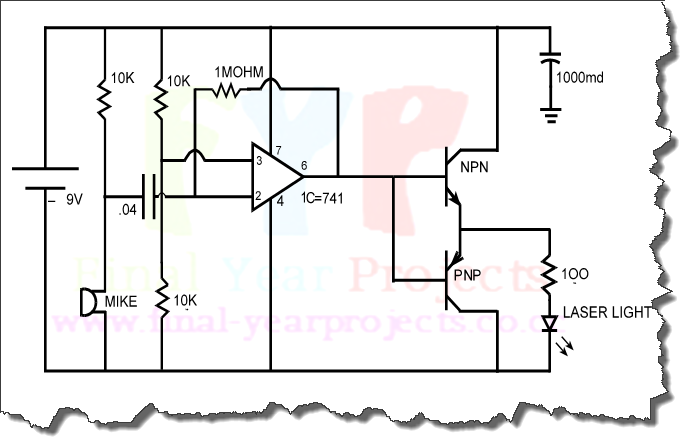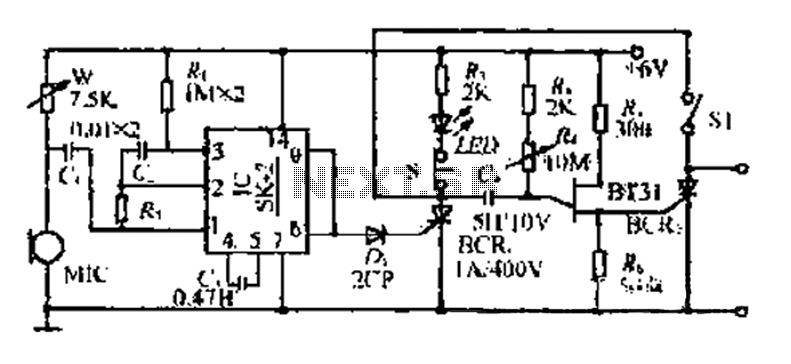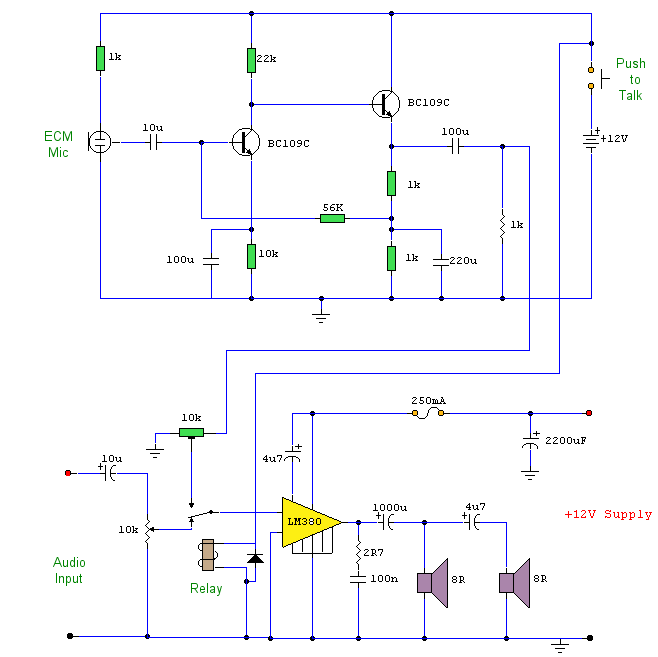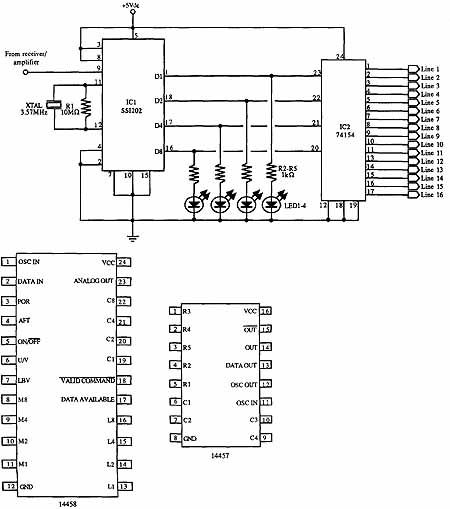
Infrared-Led based Wireless Data & Voice Communication withCircuit

The objective of this project is to design a circuit for an electronic infrared communication system, develop innovative ideas for implementing this circuit, and study the circuitry along with various components such as DTMF generators, DTMF decoders, operational amplifiers, and infrared LEDs. The primary component of the circuit is an amplifier. Sound signals, even from a distance of 2 meters from the microphone, are captured by a condenser microphone and converted into electrical variations, which are then amplified by an operational amplifier. The operational amplifier IC-741 is used in inverting mode with a single supply, utilizing a resistor divider network to set the gain by varying the feedback through a variable resistor. The output of the IC is further amplified by a push-pull amplifier using a transistor pair BC548/558. In this circuit, R2 serves as the feedback resistance, while R1 and R8, along with capacitors C1 and C3, are connected to IC-741. Pin 2 of the IC is connected to a variable resistor (VR1) through the output of transistor T1, operating on a 6-volt DC supply.
The electronic infrared communication system circuit is designed to facilitate efficient transmission and reception of signals over short distances using infrared light. The condenser microphone acts as the initial input transducer, converting acoustic signals into corresponding electrical signals. These signals are weak and require amplification for effective processing.
The operational amplifier IC-741 is configured in an inverting mode, which allows for signal inversion and amplification. The gain of the amplifier can be adjusted by changing the resistance values in the feedback loop, specifically through the use of a variable resistor (1M ohm recommended). This flexibility enables optimization of the circuit for different sound input levels and distances.
Following the initial amplification stage, the output signal is fed into a push-pull amplifier configuration using transistors BC548 and BC558. This configuration enhances the output power, allowing the signal to drive infrared LEDs effectively. The feedback resistor R2, along with resistors R1 and R8, ensures stability and proper functioning of the operational amplifier, while capacitors C1 and C3 help in filtering and smoothing the output signal.
The connection of pin 2 of the IC to the variable resistor (VR1) allows for fine-tuning of the amplifier's response, enabling users to cater to specific application requirements. The entire circuit operates on a 6-volt DC power supply, which is suitable for low-power applications and ensures safe operation of the components involved.
Overall, this circuit serves as a foundational model for developing an infrared communication system, with potential applications in remote control devices, wireless audio transmission, and other communication technologies that utilize infrared signals.Objective of this project are to Design a circuit of an electronic infrared communication system, develop new ideas to implement this circuit purposely, to study the circuitry and different types of components & DTMF generator, DTMF decoder, op-amp and infrared-LED in the circuit. The main part of Circuit is an amplifier. This sound signals (even at a distance of 2 meters from the mic) are picked up by the condenser microphone and converted into electrical variation, which are amplified by the op-amp. Operational amplifier IC- 741 is use in the inverting mode with a single supply using divider network of resistor the gain of IC can be set be varying the feed back through R5/6 resistance (can place a 1M variable) here the output of IC is further amplified buy the push-pull amplifier using transistor BC.
548/558 pair, in this circuit are R2 is feed back resistance with R1/8 and C1/3 to connected IC-741. The IC`s pin 2 is connect VR1 (variable resistance) through connect to O/P of T1 (transistor) also use 6volt DC. 🔗 External reference
The electronic infrared communication system circuit is designed to facilitate efficient transmission and reception of signals over short distances using infrared light. The condenser microphone acts as the initial input transducer, converting acoustic signals into corresponding electrical signals. These signals are weak and require amplification for effective processing.
The operational amplifier IC-741 is configured in an inverting mode, which allows for signal inversion and amplification. The gain of the amplifier can be adjusted by changing the resistance values in the feedback loop, specifically through the use of a variable resistor (1M ohm recommended). This flexibility enables optimization of the circuit for different sound input levels and distances.
Following the initial amplification stage, the output signal is fed into a push-pull amplifier configuration using transistors BC548 and BC558. This configuration enhances the output power, allowing the signal to drive infrared LEDs effectively. The feedback resistor R2, along with resistors R1 and R8, ensures stability and proper functioning of the operational amplifier, while capacitors C1 and C3 help in filtering and smoothing the output signal.
The connection of pin 2 of the IC to the variable resistor (VR1) allows for fine-tuning of the amplifier's response, enabling users to cater to specific application requirements. The entire circuit operates on a 6-volt DC power supply, which is suitable for low-power applications and ensures safe operation of the components involved.
Overall, this circuit serves as a foundational model for developing an infrared communication system, with potential applications in remote control devices, wireless audio transmission, and other communication technologies that utilize infrared signals.Objective of this project are to Design a circuit of an electronic infrared communication system, develop new ideas to implement this circuit purposely, to study the circuitry and different types of components & DTMF generator, DTMF decoder, op-amp and infrared-LED in the circuit. The main part of Circuit is an amplifier. This sound signals (even at a distance of 2 meters from the mic) are picked up by the condenser microphone and converted into electrical variation, which are amplified by the op-amp. Operational amplifier IC- 741 is use in the inverting mode with a single supply using divider network of resistor the gain of IC can be set be varying the feed back through R5/6 resistance (can place a 1M variable) here the output of IC is further amplified buy the push-pull amplifier using transistor BC.
548/558 pair, in this circuit are R2 is feed back resistance with R1/8 and C1/3 to connected IC-741. The IC`s pin 2 is connect VR1 (variable resistance) through connect to O/P of T1 (transistor) also use 6volt DC. 🔗 External reference





